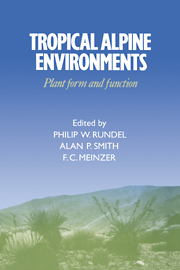Book contents
- Frontmatter
- Contents
- List of contributors
- Preface
- 1 Introduction to tropical alpine vegetation
- 2 Tropical alpine climates
- 3 Páramo microclimate and leaf thermal balance of Andean giant rosette plants
- 4 Comparative water relations of tropical alpine plants
- 5 Cold tolerance in tropical alpine plants
- 6 Anatomy of tropical alpine plants
- 7 Environmental biology of a tropical treeline species, Polylepis sericea
- 8 Morphological and physiological radiation in páramo Draba
- 9 Sediment-based carbon nutrition in tropical alpine Isoetes
- 10 Functional significance of inflorescence pubescence in tropical alpine species of Puya
- 11 Turnover and conservation of nutrients in the pachycaul Senecio keniodendron
- 12 Soil nutrient dynamics in East African alpine ecosystems
- 13 An overview of the reproductive biology of Espeletia (Asteraceae) in the Venezuelan Andes
- 14 Population biology of Mount Kenya lobelias
- 15 Population biology of Senecio keniodendron (Asteraceae), an Afroalpine giant rosette plant
- 16 Population dynamics and flowering in a Hawaiian alpine rosette plant, Argyroxiphium sandwicense
- 17 Plant form and function in alpine New Guinea
- 18 Alpine herbivory on Mount Kenya
- 19 Biotic interactions in Hawaiian high elevation ecosystems
- 20 Tropical alpine ecology: progress and priorities
- Index
11 - Turnover and conservation of nutrients in the pachycaul Senecio keniodendron
Published online by Cambridge University Press: 21 October 2009
- Frontmatter
- Contents
- List of contributors
- Preface
- 1 Introduction to tropical alpine vegetation
- 2 Tropical alpine climates
- 3 Páramo microclimate and leaf thermal balance of Andean giant rosette plants
- 4 Comparative water relations of tropical alpine plants
- 5 Cold tolerance in tropical alpine plants
- 6 Anatomy of tropical alpine plants
- 7 Environmental biology of a tropical treeline species, Polylepis sericea
- 8 Morphological and physiological radiation in páramo Draba
- 9 Sediment-based carbon nutrition in tropical alpine Isoetes
- 10 Functional significance of inflorescence pubescence in tropical alpine species of Puya
- 11 Turnover and conservation of nutrients in the pachycaul Senecio keniodendron
- 12 Soil nutrient dynamics in East African alpine ecosystems
- 13 An overview of the reproductive biology of Espeletia (Asteraceae) in the Venezuelan Andes
- 14 Population biology of Mount Kenya lobelias
- 15 Population biology of Senecio keniodendron (Asteraceae), an Afroalpine giant rosette plant
- 16 Population dynamics and flowering in a Hawaiian alpine rosette plant, Argyroxiphium sandwicense
- 17 Plant form and function in alpine New Guinea
- 18 Alpine herbivory on Mount Kenya
- 19 Biotic interactions in Hawaiian high elevation ecosystems
- 20 Tropical alpine ecology: progress and priorities
- Index
Summary
Pachycaul senecios from the upper Afroalpine zone produce stems up to 11 m tall which are coated with marcescent leaves. Each stem or branch is terminated by a huge leaf rosette composed of 30–120 leaves which surround the central cone-shaped leaf-bud. During the course of a year about 50–60 leaves are produced from the bud (Beck et al. 1980) and in principle the same number of mature leaves at the outer periphery of therosette become senescent and die. The leaves are up to 50 cm long and 15–20 cm wide. Senescence commences at the tip which becomes yellow and subsequently necrotic. Yellowing of the lamina spreads from the tip downwards to the base. A senescing leaf, the upper part of which was already partially necrotic, was found to be still capable of photosynthesis in the lower part (E. Beck, unpublished data). This mode of gradual senescence suggests that a substantial portion of the nutrients can be mobilized and exported from the leaf before it dies. Table 11.1 shows the disappearance of nitrogen in the senescing leaf. The plant was located at 4200 m elevation in the Teleki Valley, Mount Kenya. The prolonged viability of the midribs presumably facilitates this mobilization. This type of internal recycling of nitrogen and other nutrients is common in higher plants. However, unlike the majority of the higher plants the pachycaul groundsels do not shed the dead leaves but maintain them as a dense collar around the stem.
- Type
- Chapter
- Information
- Tropical Alpine EnvironmentsPlant Form and Function, pp. 215 - 222Publisher: Cambridge University PressPrint publication year: 1994
- 4
- Cited by



